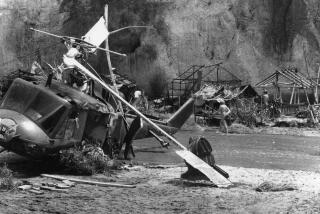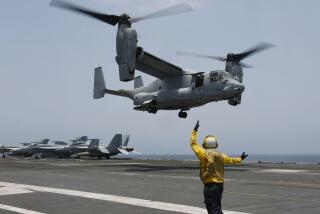Helicopter Firm Held Liable in Death of Pilot
- Share via
An Orange County jury Tuesday found the world’s largest manufacturer of helicopters liable for installing a dangerously faulty fuel system in one of its models, a helicopter widely used by law enforcement, fire departments and television news crews.
The jury also found Bell Helicopter Textron Inc. responsible for the death of veteran pilot Floyd Hiser, who was fighting a forest fire four years ago when gas stopped flowing to his engine and his helicopter plummeted into the San Bernardino Mountains. The jury awarded his widow, Sharon Hiser, $8.7 million in damages.
Attorneys for Bell declined to comment other than to say they probably will appeal the verdict. But they said in court that the fuel system works properly and that their aircraft have a good safety record.
Jurors, however, chastised the company outside of the courtroom, saying it appeared to many of them that Bell was intentionally covering up problems with the aircraft.
“Bell Helicopter knew it had a problem and didn’t do anything about it,” said juror Bryan Curtis, 42. “Part of the problem some of us have about this is that Bell still does not admit it has a problem.”
Said fellow juror Scott Watts, 28: “Basically, if I were a pilot in a Bell 206L-1 and it had a similar fuel system, I’d worry.”
At issue are about 1,700 Bell 206L-1 “Long Ranger” choppers produced in the 1980s.
Though federal regulators have never found fault with the fuel system design, they have received complaints from pilots across the country who reported the aircraft lost power in midair. At one point, regulators issued a warning letter to pilots to make sure to properly service the fuel system.
In later models of the “Long Ranger,” Bell changed the design of the fuel system. But company officials said the change had nothing to do with any problems in the early models.
Throughout the trial, Sharon Hiser’s lawyer argued that Bell engineers were aware of a fuel system flaw in early models of the helicopter that trapped fuel in reserve tanks and starved the engine for gas. Douglas Schroeder, of the Irvine law firm Speiser Krause, argued that the Texas-based manufacturer had developed a safety device that would warn pilots of a problem, but for unknown reasons, refused to alert helicopter owners of its need and availability.
Bell maintained there were no problems with its fuel system. Bell lawyers argued that the 20-year pilot simply failed to put enough gas in the helicopter before flying off to douse a raging wildfire near Highland.
After Tuesday’s verdict, a tearful Sharon Hiser, 52, thanked jurors for refusing to believe her husband had flown recklessly.
“I think there is justice after all,” she said. “Floyd didn’t do anything wrong. He was trapped. He had no place to go. I just hope Bell fixes this problem, because I still have a lot of friends who fly them.”
Floyd Hiser, 51, was working as a contract pilot for the U.S. Forest Service, dumping hundreds of gallons of water on San Bernardino County’s Hemlock Fire, when he suddenly keyed his radio and shouted “Mayday . . . I have flameout . . . I’m going down.”
Unable to perform a successful autorotation--a maneuver that pilots use to cushion a crash if they lose power--Hiser’s craft shattered on a canyon slope. Hiser died shortly after emergency crews rappelled to the crash site and pulled his gasoline soaked body from the crumpled helicopter.
Federal crash site investigators found that fuel had stopped flowing into the aircraft’s engine, although there appeared to be gas in the forward reserve gas tanks.
At trial, Sharon Hiser’s lawyer argued that Hiser’s last flight would have had a very different outcome had Bell warned him and others about problems and required installation of a so-called selectable fuel quantity switch. The switch, Schroeder said, would enable pilots to monitor the level of fuel in the chopper’s main and reserve tanks. This gauge would show pilots whether fuel was being trapped in the reserve tanks and allow them time for an emergency landing.
The case was heard in Orange County Superior Court in Santa Ana rather than Texas, because the suit originally named a local valve manufacturing firm as a co-defendant. That firm was since dismissed from the case.
More to Read
Inside the business of entertainment
The Wide Shot brings you news, analysis and insights on everything from streaming wars to production — and what it all means for the future.
You may occasionally receive promotional content from the Los Angeles Times.











